"Inside information" on work in:
A
MILK FACTORY.
VERY few Londoners
ever bother to think of how their morning pint of milk really gets
to their doorstep. Little do they realise, until they have lived in
the country and seen it in action, the enormous organisation that is
required to take their pint of milk from the cow to their doorstep.
On being evacuated I was billeted with a dairy-man, and I was thus
able to learn quite a lot about the milk industry, and was able to
go over the Cheddar Valley Dairy Company's milk factory at
Rooksbridge.
Cows are milked at dawn, and also again at dusk. The milkers turn out in all weathers, with their dog in their carts,
each carrying two churns, and sit on their peculiar stools milking.
The cows become accustomed to milking and assemble in a corner of
the field. Often nowadays the herds return to the farm-houses, where
they are milked by electricity. The churns, each containing some 12
gallons of milk, are placed on wooden benches at the roadside, ready
to be collected by vans. The next stage, the collection of the
churns, is done by the factory itself. (A "factory" here is not a
manufacturing workshop but a collecting centre). Vans are sent out
to collect the churns from the neighbouring district. Each full
churn is replaced by an empty, clean one. These vans rush the milk
back to the factory - rush is the correct word, for one never sees a
milk van going slow.
In the
evening the milk is brought into the factory. The vans back against
a raised platform and the full churns are unloaded and inverted over
a large tank, into which the milk drains. This tank supplies the
various plants of the factory. The churns themselves are placed on
one side to be washed. This is accomplished by inverting them over a
jet of steam and swilling them with a hose. The jet, rising from the
floor, makes an almost unbearable noise. The churns are not allowed
to dry before they are rushed out again, once more to be filled with
milk. The whole cleaning process is only a matter of a few minutes.
The milk
itself is fed to the pasteuriser. This machine brings the milk up to
boiling points during its passage through it, thus destroying any
disease. Now the milk is very hot. In this condition it is passed
through the separator, the cream running out at one pipe and
ordinary milk out at the other. skimmed milk results; it comes when
ordinary standard milk is separated to give cream for butter-making.
To cool the milk it is dropped over a series of pipes about 2ins. in
diameter, filled with freezing brine fed from a freezing plant. The
milk is collected in another tank, from which it can be run into
fresh churns or loaded directly into the railway containers to be
sent to London. The churns pass out of the other side of the factory
into vans to be carried to the neighbouring station, in my case
Brent Knoll, from where it is sent to London to be bottled and
delivered. The power for all these various plants comes from a huge
boiler. This furnace is far away from the factory itself, for the
resulting heat would not have a favourable effect on the milk in
summer. The atmosphere in the factory is one of continuous hurry and
bustle. Nobody seems short of some task or other. The noise is
terrific. The machinery rattles continuously; the cooling plant
pumps away methodically; whilst escaping steam from the pasteurising
plant and the jet for cleaning the churns is sufficient to augment
all the other noises into one big din. Another noticeable fact is
the ease with which the churns are moved. The floor is made
throughout of iron grating to facilitate their easy movement. The
workmen, moreover, are extremely clever at rolling them, whether
full or empty. This may look simple to townsfolk, but to roll a full
churn is a very delicate job. The railway provides all transport to
London, the chief consumer for all South England. Thus the milk is
taken to the towns. Never is there a shortage; seldom is any wasted.
The milk once bottled is delivered to the householders in the
morning, the whole process taking place in less than 24 hours.
P. MANNERS (L.6 Modern)
A
typical day at the dairy would
start very early in the morning, say at 4.30am, when the boilerman
would get up steam ready for the cheesemaker.
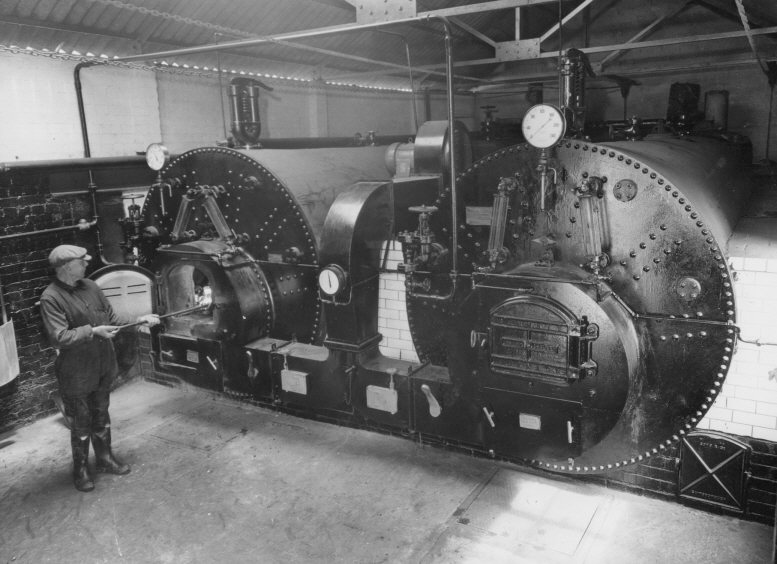 |
The Early Shift!
Ernie Popham stoking
the coal fired boilers.
During the 1950's
these boilers were converted to heavy fuel oil burners and
were virtually able to maintain the correct head of steam
unsupervised.
It saved a lot of raking and shovelling coals !
Part of the early
morning boilermans duty, was to get a good head of steam to
heat the milk in the cheeseroom ready for the Cheesemaker to
add the starter when he came in.
photo: courtesy R
Brown. |
|
The Cheese maker would arrive at about
5-30am to add a rennet starter to the heated milk which would begin
the 'Cheddar-ing' process.
The seven 1000 gall
milk vats on the upper deck -some seen here- held milk that was
heated and stirred and starter then added at the
correct temperature. (Getting the amount of starter and the
temperature correct is part of the skill of the cheesemaker)!
Once the first part of the process was complete, the curdled
milk was drained into the lower cheddar-ing vats, where the
whey drained from the cheese. The solidified curd is then
cut with large knives, into manageable blocks and
continually turned and stacked until all the whey is
drained. When it is then milled and the salt added.
The milled cheese is then packed into 60lb truckle moulds
lined with cheesecloth. These cheese moulds were then pressed for
several days in huge gang presses to compact and remove any
excess moisture from
the cheeses.
|
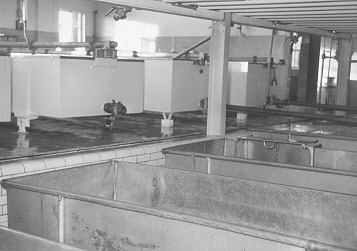
Cheeseroom 1980's
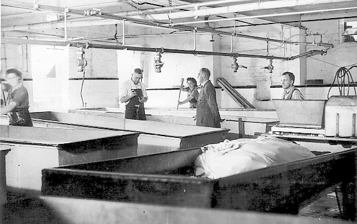
Cheeseroom 1947
photo: courtesy R
Brown. |
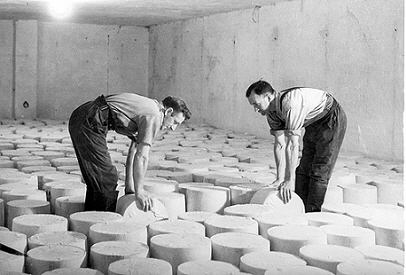
Stan Body and an
assistant turn the maturing cheddars.
photo: courtesy R
Brown. |
When the cheeses were removed
from the presses, they were stamped with vat numbers, dated
and then placed into store.
Here the cheeses were turned
daily while maturing, sometimes up to a year or more, depending on
the flavour required. |
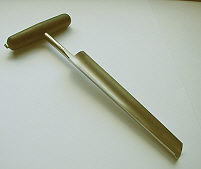 Once
the stored cheeses reached the age of maturity and flavour
required. Using his cheese sampling plug cutter tool. The cheesemaker would sample the batch for flavour
and texture etc.
This enabled him to know how a particular batch would grade
when tested by the wholesalers cheese grader. Once
the stored cheeses reached the age of maturity and flavour
required. Using his cheese sampling plug cutter tool. The cheesemaker would sample the batch for flavour
and texture etc.
This enabled him to know how a particular batch would grade
when tested by the wholesalers cheese grader.photos: courtesy Richard
Brown and Richard Popplestone. |
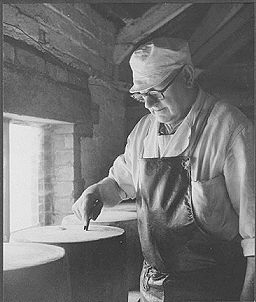
Frank Page grading a
batch of cheddars |
A standard truckle of Cheddar cheese
weighed 60 lbs. 9 lbs and 4 lbs truckles were also made, along
with miniature 1/2 lbs and 1 lbs waxed cheeses mainly for the
Cheddar tourist trade.
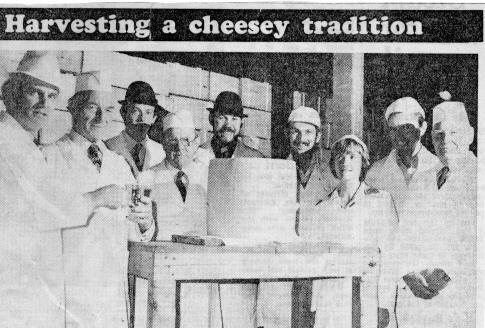
photo
courtesy: Western Daily Press. |
It was always tradition, that a special giant 112 lbs cheese was
made and presented to the East Brent Harvest Home every year! (The
last of these was made and paraded in 1981).
Head cheesemaker Jim
Andrews came out of retirement in 1981 to dress and prepare
the very last Harvest Home cheese, and to receive a tankard
on his retirement, from manager Richard Brown.
Also in the photo are: Steve Perkins. Production Manager,
Stan Burden. Engineer, Dennis Cottle. Area manager, Gilbert
Pike. Cheeseroom foreman, Margaret Poole. Laboratory, John
Holdenby. Bottling supervisor and Pete Lewis. Customer
Liason. |
While the cheese made by CVD was usually made as
60 lbs traditional farmhouse truckles, gradually, with the demand for pre
packed cheese for supermarkets etc, block cheese was increasingly
produced in 40 lbs blocks. Until
the mid 1950's, batches of Caerphilly, Cheshire and Double
Gloucester were also produced.
At its peak, the dairy was
manufacturing over 18,000 tons of cheese per year.
To expand production further would have
cost over £500,000 for a complete refit of equipment and buildings.
The decision was made to expand cheesemaking facilities at the
Horlicks Dairy in Ilminster. And in 1981 after a hundred years, cheese
making at Rooksbridge ended!
|
1964 and two
proud cheesemakers claim another clutch of awards!
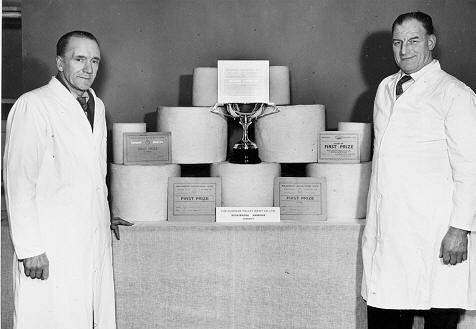
Cheesemakers Stan Body
and Jim Andrews show off their Mid Somerset show trophies
photo: courtesy R
Brown. |
|